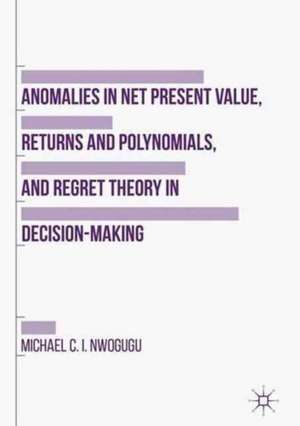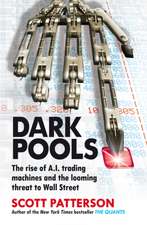Anomalies in Net Present Value, Returns and Polynomials, and Regret Theory in Decision-Making
Autor Michael C. I. Nwoguguen Limba Engleză Hardback – 21 iun 2017
Preț: 949.55 lei
Preț vechi: 1157.98 lei
-18% Nou
Puncte Express: 1424
Preț estimativ în valută:
181.72€ • 197.32$ • 152.64£
181.72€ • 197.32$ • 152.64£
Carte tipărită la comandă
Livrare economică 22 aprilie-06 mai
Preluare comenzi: 021 569.72.76
Specificații
ISBN-13: 9781137446978
ISBN-10: 1137446978
Pagini: 256
Ilustrații: XIII, 327 p.
Dimensiuni: 148 x 210 mm
Greutate: 0.56 kg
Ediția:1st ed. 2016
Editura: Palgrave Macmillan UK
Colecția Palgrave Macmillan
Locul publicării:London, United Kingdom
ISBN-10: 1137446978
Pagini: 256
Ilustrații: XIII, 327 p.
Dimensiuni: 148 x 210 mm
Greutate: 0.56 kg
Ediția:1st ed. 2016
Editura: Palgrave Macmillan UK
Colecția Palgrave Macmillan
Locul publicării:London, United Kingdom
Cuprins
Chapter 1) Introduction.- Chapter 2) Spatio-Temporal Framing Anomalies in the NPV-MIRR-IRR Model and Related Approached, and Regret Theory.- Chapter 3) Regret Theory and Asset Pricing Anomalies in Incomplete Markets with Dynamic Un-aggregate Preferences.- Chapter 4) The Descartes Sign Rule and The Fourier-Budan Theorem are Wrong.- Chapter 5) MN-2 Invariants and Homomorphisms for Solving Polynomials; and Anomalies in The Binomial Theorem And The “Fundamental Theorem Of Algebra.- Chapter 6) The Historical And Current Concepts Of “Plain” Interest Rates and Forward Rates are, or Can Be, Misleading.- Chapter 7) On Algebraic Anomalies in Polynomials and Net Present Value Decisions.- Chapter 8) Some Biases And Evolutionary Homomorphisms Implicit in The Calculation Of Returns.- Chapter 9) Conclusion.- Chapter 10) References.
Notă biografică
Michael C. I. Nwogugu is an author, entrepreneur and consultant, who has held senior management and Board-of-Director positions in companies in both the US and Nigeria. Mr. Nwogugu’s articles have been published in Applied Mathematics & Computation; Journal of Risk Finance; International Journal of Mathematics, Game Theory & Algebra; Discrete Mathematics, Algorithms & Applications; Corporate Ownership & Control; and Chaos & Complexity Letters. Mr. Nwogugu earned degrees from the University of Nigeria (Nigeria), the City University of New York (USA), and Columbia University (New York City, USA). Mr. Nwogugu’s book, Risk in the Global Real Estate Market (John Wiley, 2012), addresses various aspects of risk, mechanism design, household intertemporal allocations and constitutional economics; and introduces new and more efficient financial products.
Textul de pe ultima copertă
This book explores why Internal Rate of Return (IRR) and Net Present Value (NPV) are not necessarily accurate or efficient tools for valuation and decision-making. The author specifically addresses the discounting biases and framing effects inherent in the NPV/MIRR/IRR model and in related approaches such as Adjusted Present Value (APV), Net Future Value (NFV) and by extension, Polynomials. In doing so, the book presents a new way of solving higher order polynomials using invariants and homomorphisms and explains why the “Fundamental Theorem of Algebra”, the Binomial Theorem and the “Descartes Sign Rule” are unreliable. Chapters also discuss how Intertemporal Asset Pricing Theory (IAPT) and Intertemporal Capital Asset Pricing Models (ICAPM) can produce inaccurate results in some circumstances. The conditions under which ICAPM and IAPT may be accurate are described; as well as why those conditions cannot, or are unlikely to exist. The conditions under which negative interest rates may exist or are justified are also outlined. Moreover, the author explains why traditional Consumption-Savings-Investment-Production models of allocation can be inefficient, and then introduces a new model of allocation that can be applied to individuals, households and companies. Finally, the book explains why the Elasticity of Intertemporal Substitution is a flawed concept and introduces the Marginal Rate of Intertemporal Joint Substitution.
Caracteristici
Provides a highly technical analysis of business valuation and decision-making models Offers empirical examples of new and applied business models Evaluates current methods of decision-making using a rigorous mathematical approach











